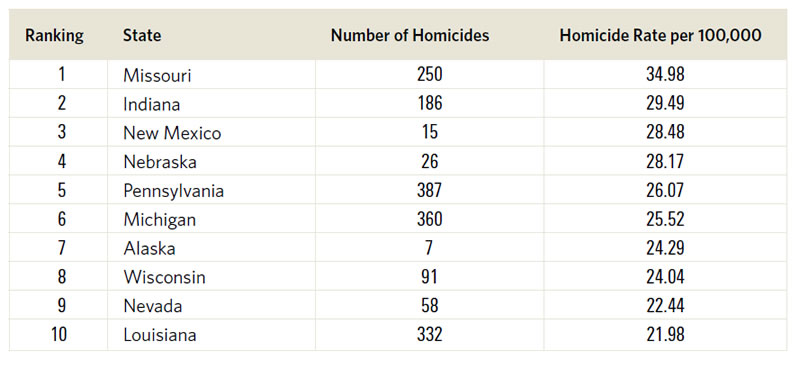For Release: Tuesday, March 28, 2017
87 percent of black homicide victims in Missouri were killed with guns
Washington, DC — Missouri has the highest black homicide victimization rate in the nation with a rate of 34.98 per 100,000, which is more than double the national black homicide victimization rate and more than eight times the overall homicide rate nationwide, according to a new analysis by the Violence Policy Center (VPC).
The annual study, Black Homicide Victimization in the United States: An Analysis of 2014 Homicide Data, ranks the states according to their black homicide victimization rates. It is based on unpublished data from the Federal Bureau of Investigation (FBI) Supplementary Homicide Report (SHR). The study details homicide rates for 2014, the most recent year for which comprehensive national data is available. This is the eleventh year the Violence Policy Center has released the study. To see past editions of the study, click here.
“Each year this report reveals the devastating and disproportionate impact homicide, almost always involving a gun, has on black men, boys, women, and girls in America,” states VPC Executive Director Josh Sugarmann. “These deaths devastate families and traumatize whole communities. We hope our research will not only help educate the public and policymakers, but aid community leaders already working to end this grave injustice.”
In Missouri, there were 250 black homicide victims in 2014, resulting in a homicide rate of 34.98 per 100,000. That year, the national black homicide rate was 16.38 per 100,000, and the overall national homicide rate was 4.19 per 100,000.
For homicides in which the weapon used could be identified, 87 percent of the black homicide victims in Missouri were shot and killed with guns. Nationwide, 83 percent of black homicide victims were killed with guns.
The 10 states with the highest black homicide victimization rates in 2014 were:
For MISSOURI, the study finds that in 2014:
· Of the 250 black homicide victims, 217 were male and 33 were female.
· Twenty-two black homicide victims (9 percent) were less than 18 years old and 1 victim (less than 1 percent) was 65 years of age or older. The average age was 29 years old.
· When the weapon used could be identified, 87 percent of the black homicide victims (216 out of 247) were killed with guns. Of these, 52 percent (112 victims) were killed with handguns.
· For homicides in which the victim to offender relationship could be identified, 75 percent of black homicide victims (58 out of 77) were killed by someone they knew. Nineteen were killed by strangers.
· For homicides in which the circumstances could be identified, 64 percent (62 out of 97) were not related to the commission of any other felony. Of these, 77 percent (48 homicides) involved arguments between the victim and the offender.
For the entire UNITED STATES, the study finds that in 2014:
· There were 6,095 black homicide victims in the United States that year. Blacks represent 13 percent of the U.S. population yet account for 50 percent of all homicide victims.
· The black homicide victimization rate in the United States was 16.38 per 100,000. In comparison, the overall national homicide victimization rate was 4.19 per 100,000. For whites, the national homicide victimization rate was 2.52 per 100,000.
· Of the 6,095 black homicide victims, 5,263 were male and 829 were female. The homicide victimization rate for black male victims was 29.54 per 100,000. The homicide victimization rate for female black victims was 4.28 per 100,000.
· For homicides in which the weapon used could be identified, 83 percent of black victims (4,800 out of 5,773) were shot and killed with guns. Of these, 73 percent (3,506 victims) were killed with handguns.
· For homicides in which the victim to offender relationship could be identified, 72 percent of black victims (1,966 out of 2,746) were killed by someone they knew. The number of victims killed by strangers was 780.
· For homicides in which the circumstances could be identified, 71 percent (2,581 out of 3,645) were not related to the commission of any other felony. Of these, 50 percent (1,291 homicides) involved arguments between the victim and the offender.
The FBI data includes incidents reported as justifiable homicides of black victims killed by law enforcement. Nationwide, there were 115 such incidents reported in 2014. The data does not specifically identify killings by police that are not ruled justifiable. In December 2015, the FBI announced that it would dramatically expand its data collection on violent police encounters by 2017. In October 2016, the U.S. Department of Justice outlined a plan to improve the collection of law enforcement use of force data.
The study calculates black homicide victimization rates by dividing the number of black homicide victims by the black population, and multiplying the result by 100,000. This is the standard and accepted method of comparing fatal levels of gun violence.
The full study is available at http://vpc.org/studies/blackhomicide17.pdf.
The Violence Policy Center is a national educational organization working to stop gun death and injury. Follow the VPC on Twitter, Facebook, and YouTube.







